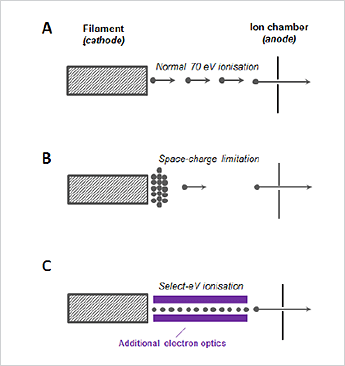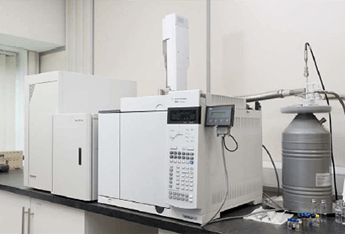Introduction
Comprehensive two-dimensional gas chromatography with time-of-flight mass spectrometry (GC×GC–TOF MS) offers greatly enhanced peak capacity, through the coupling of two columns of different selectivity, as well as highly sensitive detection and definitive mass spectral identification of trace-level analytes.

Despite this increased separation capacity, the identification of individual compounds in complex samples may be further complicated due to weak molecular ions or when similar mass spectral characteristics are evident across entire chemical classes. Select-eV® is a new innovation in ion source technology that aims to solve this problem by the ability to switch between hard and soft electron ionisation with no inherent loss in sensitivity. The use of soft electron ionisation enhances the intensity of molecular and structurallysignificant fragment ions, magnifying differences between isomeric spectra and, by consuming less instrumental dynamic range, allows a wider concentration range of analytes to be supported. This poster provides an introduction to Select-eV, as applied to GC×GC–TOF MS analyses within a range of applications, from petrochemical analyses to environmental monitoring.
Theory
In GC–MS analyses, there is conventionally a potential difference (or electron energy) of 70 eV between the ion chamber (anode) and the e-gun (cathode). In this electrical configuration, thermionic electrons are easily accelerated away from the surface of the filament and directed through an aperture in the ion chamber wall for normal electron ionisation (Figure 1A). In a properly constructed ion source, small variations in the electron energy impart very small differences to the ionisation efficiency, and thus the ion flux available for gating into the mass analyser, resulting in reliable and repeatable mass spectral results. However, at lower ionisation energies, electron emission from the filament becomes spacecharge limited. Electrons are not efficiently directed into the ion chamber, due to the lower potential difference between the anode and cathode, resulting in electron clustering around the filament, which further shields the potential difference (Figure 1B).
 Figure 1: Illustration of thermal emissions in electron ionisation. A: Conventional 70 eV ionisation. B: The space-charge limitation in conventional (EI) GC–MS systems at low ionisation energy. C: How the Select-eV ion source overcomes this problem.
Figure 1: Illustration of thermal emissions in electron ionisation. A: Conventional 70 eV ionisation. B: The space-charge limitation in conventional (EI) GC–MS systems at low ionisation energy. C: How the Select-eV ion source overcomes this problem.Until now, the space-charge limitation has hindered the use of low ionisation energies in conventional EI GC–MS due to the resulting catastrophic loss in sensitivity. In the Select-eV ion source, depicted in Figure 1C, an additional electrostatic element is placed between the e-gun and the ion chamber. In this configuration, electrons emitted from the filament are channelled efficiently into the ion chamber at the defined electron energy. Therefore, the signal is improved by reducing coulombic effects and increasing the number of electrons produced by the filament. This improves instrument sensitivity at low ionisation energies and allows soft ionisation in an e-gun arrangement.
Experimental
The Select-eV e-gun has been integrated into Markes’ BenchTOF-Select™ time-of-flight mass spectrometer, allowing generation of electrons over a wide, tuneable range of energies (10–70 eV). The electron beam is focused into an ionisation chamber that also acts as an efficient extraction chamber for the TOF instrument, maximising ion transmission rates into the mass analyser. This arrangement proved to be extremely sensitive. A GC×GC gas chromatograph (Agilent 7890 GC with Zoex ZX1 modulator) was used in combination with the BenchTOF-Select for the following case-studies.
 Figure 2: BenchTOF-Select with GC×GC.
Figure 2: BenchTOF-Select with GC×GC.




